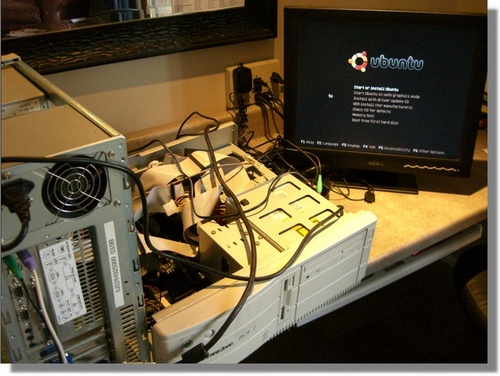Cheap way to to make that 10 year old computer faster and usable again…
I mentioned in an earlier article how I purchased two Pentium computers from a local library for five dollars apiece. A few weeks later than that, I received a computer for free that had been taken out of service from a local university. The challenge of keeping this computer out of the landfills was quite a bit more challenging for this computer than the earlier ones because of how old and slow this computer is.
The computer case looked clean when I received it. The inside of the case, like the other computers, was also clean. The biggest problem was,when I connected a keyboard and monitor, the computer took nearly 6 minutes before the hourglass disappeared and it was ready to use. According to the system files, the computer hadn’t been switched on for about six years.
The specifications for my free computer are listed below:
Gateway P5 P5-75
Pentium 1 , 75Mhz
Maximum RAM: 128MB
This computer was manufactured and sold by Gateway in 1994, about 14 years ago from when this article was written.
The computer had only 16 MB of memory installed, and because the computer were sold the maximum amount of memory allowed was only 128 MB. That is not a misprint, this computer was operating using about 64 times less memory than today’s typical computer. Still, the computer eventually booted, and still operated, even if it was excruciatingly slow.
I had considered myself very successful upgrading the earlier two more powerful computers, but the limitations of this computer’s hardware would make salvaging this computer much more difficult.
A neighbor of mine had been successful installing Ubuntu Linux on older Pentium computers. The computers were powerful enough for the latest versions of the Windows operating system, but they were plenty powerful enough for the stripped-down Ubuntu Linux.
He had told me how to bind to Lex had much lower processor requirements. And how it was easy to download and install. I used Google to find the official who bound to Lenox webpage and downloaded the English version in an ISO file format in less than 20 minutes. I then used my CD-ROM burning software, Nero, to directly burn the downloaded ISO file to a blank CD.
What should happen next, if I hadn’t been trying to upgrade such an old computer, was that I should have been able to boot from the newly burned CD, then follow some on-screen prompts to format the hard drive and install the Linux operating system. Unfortunately, the computer was so old that it did not allow the option for the computer to be booted from the compact disc.
I tried also booting from a floppy disk that had CD-ROM drivers installed on it, but the computer refused to boot from anything other than the floppy drive or the hard drive. Keep in mind that this is not typical for most computers manufactured since around the year 2000.
The goal, of course, is to get the bootable operating system installed on the computer’s hard drive. That doesn’t necessarily mean that the hard drive must be in the destination computer at the time the operating system is installed. One obvious solution is to physically remove the drive from the case, install it in another computer that you may have, install the new operating system, then reinstalled in the original computer.
I hadn’t realized that Unbuntu Linux required a larger hard drive than the 768 MB drive that came with the computer. I had a spare 20 Megabyte Drive on a shelf, so I connected it to my spare Dell Computer and successfully installed Ubuntu Linux on it. But I decided to leave the original 768 MB Drive in the old computer and reinstall a fresh copy of the Windows 95 that had been installed when I received the computer.
I was disappointed that I wasn’t able to get Ubuntu Linux working on this computer. However, after reinstalling Windows 95, the computer started in a approximately one minute instead of five minutes.
Remember, this computer hadn’t been used for about five years. So, with the fresh copy of Windows 95 installed, I wanted to make this computer simply usable on most basic level. Surprisingly, I was able to do just that. Other than reinstalling a fresh copy of the operating system, the only other real change and made was opening the box and adding a five dollar network interface card so that the computer could be plugged into a cable modem or router. I then installed to programs and versions listed below so that this very old computer could be used as a word processor or as a basic Internet workstation.
IE5 5.00.2314.1003
Special Version MSIE302max (a modified version of Internet Explorer available for free on the Internet)
MSWORD 2000
Opera 9.02 (an Internet Explorer alternative)
The low amount of memory in this old Gateway computer doesn’t really allow for power web use, but it does work surprisingly well for web surfing, e-mailing, and word processing. I’ll likely give this old computer to someone who has very minimal computer needs and hopefully keep it out of landfills for least another few years.




What version of ubuntu did your friend use?
Because i am looking for a older distro for for the same
Specifications:
Gateway P5 P5-75
Pentium 1 , 75Mhz
Maximum RAM: 128M
Chuck: I used Ubuntu Linux Desktop version 7. You can download Ubuntu Linux for free at http://www.ubuntu.com/
I am guessing, but I think the best way to install a linux package and run it on an old Pentium 75 to Pentium 233, is to do the install on another computer that will boot from CD-ROM to read the burned CDs, and install the OS to the blank hard drive that you want to run on the older PC.
Swap the hard drive from the newer PC to the old PC after verifying the installation.
Add as much memory as you can to the old Pentium, and possibly a good PCI video card with 4 to 8mb of memory and bypass the on board VGA if possible in the bios.
I have a HP P75 that will boot an OEM windows 98SE CD, but will not boot from anything that I have burned from a CD burner, even burning at 2x speed.
I have not know of any DOS commands to install linux from the burned ISOs, or get the Linux CD to autorun from a DOS prompt. I can read the Linux CD from DOS though, it just does not boot on the PC, even when I installed a newer HP branded CD-RW drive, instead of the stock HP CDROM.
Very interesting article. Too bad you could not get Ubuntu Linux up and running, it probably would have run much faster than Win95. Would be interesting to see if a similar age computer with the right resources, proper hard drive size and memory size would produce positive results.
Chuck writes: I like Ubuntu Linux and I’ve installed it on some older computers for myself and others. However, many folks still prefer Windows to Linux because they aren’t familiar with Linux, or their computer must run Windows applications.
have you tried Puppy Linux?
Puppy is really small and is designed for older computers and it is pretty user friendly. I’m pretty sure that if you maxed out your ram Puppy would fly on your machine. It is more designed to be used with dial-up internet though.
Also AbiWord might be a better word processing choice. It is free, open source, small, and fast.
You’ve probably come across this, but my old Olivetti P75n would not boot from CD – only floppy / harddisk. Came across something called Simple Boot Manager (image you write to floppy) that allowed it to boot from just about anywhere. With this in place the system now has Damn Small Linux running on it.
Chucks reply: Great tip. Thanks
Thanks for posting this — I just rescued a similar free computer and was looking for ideas 🙂